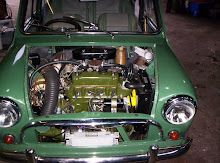The circular housing at the side of the distri¬butor contains a diaphragm which responds to the variations that occur in the partial vacuum in the induction system. When the engine is running at a moderately high speed with the throttle partly closed—under main-road cruising conditions, for example—a relatively high vacuum exists and the diaphragm of the vacuum control unit is drawn upwards, rotating the contact-breaker baseplate in a clockwise direction against the direction of rotation of the cam, and thus advancing the ignition timing. When the engine is pulling hard at low speeds with a wide throttle-opening, on the other hand—conditions which call for a retarded ignition timing to prevent detonation and "pinking"—the vacuum in the induction system is low and the diaphragm is returned by spring pressure. The contact-breaker assembly then rotates anti-clockwise and the ignition is retarded.
It will be seen that the action of the vacuum control either complements or opposes the action of the centrifugal control, ensuring that the most effective timing is maintained under all conditions of load and speed. A further point is that the suction connection for the vacuum control is not made directly into the induction pipe but through a small drilling in the carburettor just on the atmospheric side of the throttle plate, so that the control is out of action when the throttle is closed and the engine is idling (when the vacuum in the ignition system is high), thus preventing excessive ignition advance under these conditions.
Thursday, 15 October 2009
Vacuum Timing Control
Posted by Info Mini Cars at 02:32
Subscribe to:
Post Comments (Atom)


0 comments:
Post a Comment